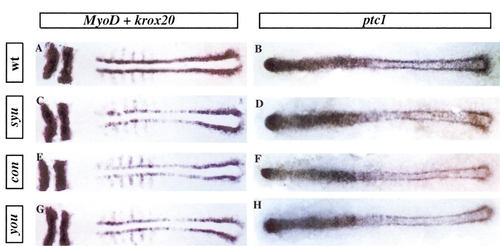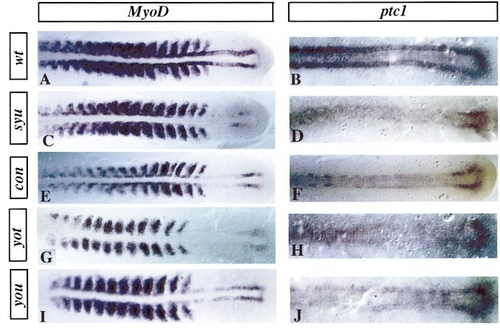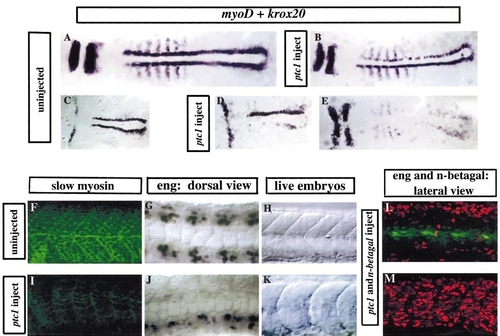- Title
-
Control of muscle cell-type specification in the zebrafish embryo by hedgehog signalling
- Authors
- Lewis, K.E., Currie, P.D., Roy, S., Schauerte, H., Haffter, P., and Ingham, P.W.
- Source
- Full text @ Dev. Biol.
|
Early expression of ptc1 and MyoD in yot homozygotes. yot homozygotes have reduced expression of ptc1 (B) and myoD (D) compared to wild type (A and C, respectively). ptc1 is still expressed throughout the adaxial cells (B) but at much lower levels than in wild-type (A), whereas MyoD is expressed only in the tailbud and most posterior adaxial cells (D). Note that the embryos were also hybridised with a probe for krox-20. The anterior stripe of expression that this reveals provides a spatial reference point and a control for staining levels. EXPRESSION / LABELING:
|
|
Expression of ptc1 and MyoD in syu, con, and you at five to six somites. Dorsal flat preparations of embryos hybridised with probes for MyoD and krox-20 (A, C, E, and G) or ptc1 (B, D, F, and H). The krox 20 expression serves as a control for staining levels. (A and B) Wild-type embryos: note the strong expression of myoD in the adaxial cells and much weaker expression in the rostral somites. Expression of ptc1 overlaps myoD in the adaxial cells; note also the strong expression in the rostral neural tube. (C and D) syu, (E and F) con, (G and H) you; in all three mutants there is a slight reduction in the levels of expression of ptc1 and reduced and discontinuous expression of MyoD in the adaxial cells. EXPRESSION / LABELING:
|
|
ptc1 and MyoD expression at 10–15 somites. (A) Expression of myoD in 15-somite and (B) ptc1 in 10- to 12-somite stage wild-type (wt) embryos. At the 12- to 15-somite stage, the expression of myoD is reduced in the adaxial cells of embryos homozygous for syu (C), con (E), yot (G), and you (I). Note the persistent expression in the tailbud in yot homozygotes (G). Lateral somite expression of myoD is also slightly reduced in the most rostral somites, most notably at this stage in syu, con, and yot. Expression of ptc1 is also reduced in the adaxial cells of syu (D), con (F), yot (H), and you (J) homozygotes at the 10- to 12-somite stage. EXPRESSION / LABELING:
|
|
Expression of ptc1 at late somitogenesis stages in wild-type and mutant embryos. Specimens are oriented dorsal side up, anterior to the left unless otherwise stated. (A–G and J) 18- to 20-somite stage embryos; (H, I, and K–P) embryos at 26–30 somites. Specimens in E–G were stained with mAb 4D9 to reveal the expression of Eng proteins: arrows indicate Eng expression in MPs; square brackets indicate Eng expression in the midbrain/hindbrain region. (A) Wild-type expression of ptc1; (B) syu and (D) yot homozygotes showing strong reduction in ptc1 expression. The specimen in (C) showing a slight reduction in ptc1 expression is presumed to be a yot heterozygote. (F) con homozygote, identified by the lack of somitic Eng expression (compare to the wild-type sibling shown in (E)), exhibiting a strong reduction in ptc1 expression. (G and J) Details of embryos shown in (E and F) illustrating the simultaneous loss of ptc1 expression and loss of muscle pioneers in con homozygotes. Lateral (H and K) and dorsal (I and L) views of wild-type and you homozygous embryos showing reduction in expression of ptc1 in somites and neural tube, also shown at lower magnification in (M). (N) ubo homozygote at same stage as (M) showing normal expression of ptc1. (O) Lateral view of trunk region of a 26- to 30-somite stage wild-type embryo stained with mAb 4D9 to reveal Eng expressing MPs. Each somite has a small number (1–5) of cells that express high levels of Eng proteins located in the middle of the somite adjacent to the notochord. (P) ubo homozygotes do not form MPs but have clusters of cells expressing lower levels of Eng similar to those that surround MPs in wild-type embryos: note that this embryo was stained longer than that shown in (O) to reveal the lower level Eng staining. EXPRESSION / LABELING:
|
|
Expression of slow and fast myosin in wild-type and mutant embryos. Separated and merged immunofluorescence images of transverse sections of 26- to 30-somite stage embryos stained for fast MyHC (red) and slow MyHC (green). (A, F, and K) Wild-type embryo. Most of the slow-myosin-expressing cells have by this stage migrated to the lateral edge of the somite with the exception of the MPs that remain close to the notochord at the midline of the somite. (B, G, and L) yot homozygote; note the complete absence of all slow myosin expression. (C, H, and M) syu homozygote showing reduction in the number of cells expressing slow myosin; note that these have migrated correctly. (D, I, and N) you homozygote showing reduction in slow-myosin-expressing cells similar to that seen in syu. Note that some cells fail to migrate. (E, J, and O) A con homozygote showing normal distribution of slow muscle cells except for the absence of MPs (compare F and J). EXPRESSION / LABELING:
|
|
Overexpression of ptc1 suppresses slow muscle specification and MP induction. (A–E) Embryos at early somitogenesis stages and (F–M) embryos at 24 hpf. (B, D, and E) Dorsal flat preparations illustrating the variable effects on adaxial myoD expression following overexpression of ptc1. These range from near elimination of adaxial MyoD expression (E) to a reduction in transcript levels (B) reminiscent of the effects of syu, con, or you mutations (compare with Figs. 2C, 2E, and 2G). The unilateral effects in B and D are most likely due to the unequal distribution of the injected mRNA. (F and I) Lateral view of an uninjected embryo and a sibling embryo injected with ptc1 mRNA stained with an antibody (BA-D5) that recognises slow muscle myosin. Note the strong staining of the muscle fibres and distinct chevron shape of the somites in the uninjected embryo (F). Very few slow muscle fibres are detectable with the BA-D5 antibody in the ptc1-injected embryo at 24 h. Note also the absence of the horizontal myoseptum and the u-shaped somites of this embryo. (G and J) Dorsal views of an uninjected embryo and a sibling embryo injected with ptc1 mRNA, stained with the 4D9 mAb to reveal Eng expression. Note the complete elimination of MPs on one side of the notochord in the ptc1-injected embryo. (H and K) Somites of live embryos at 24 hpf. The embryo injected with ptc1 (K) has u-shaped somites, reminiscent of the u-type mutants; compare with the chevron-shaped somites of the wild-type embryo (H). (L and M) Eng expression in the MPs (green staining) in embryos co-injected with ptc1 and n-βgal mRNAs. In (L) the majority of the injected message (as revealed by distribution of the N-βgal protein, red staining) is localised to the neural tube and there is no effect on MP induction as revealed by wild-type pattern of Eng protein expression in the somites. Also note that the somites are chevron shaped as in wild-type embryos. The low level Eng expression in a cloud of nuclei around the MPs is in the adjoining fast muscle fibres. In the embryo shown in (M), in contrast, there is a large amount of injected message that is localised in the somites as revealed by the distribution of the N-βgal protein. In this case, there is no detectable Eng expression, indicating that MP induction has been inhibited in the Ptc1-expressing somitic cells. Note the u-shaped nature of the somites. |
Reprinted from Developmental Biology, 216(2), Lewis, K.E., Currie, P.D., Roy, S., Schauerte, H., Haffter, P., and Ingham, P.W., Control of muscle cell-type specification in the zebrafish embryo by hedgehog signalling, 469-480, Copyright (1999) with permission from Elsevier. Full text @ Dev. Biol.






